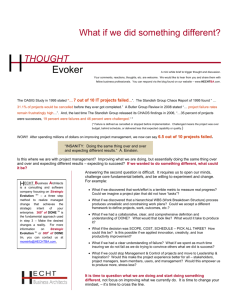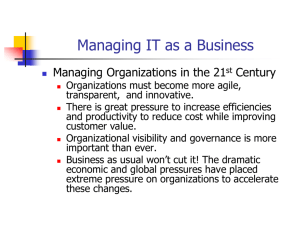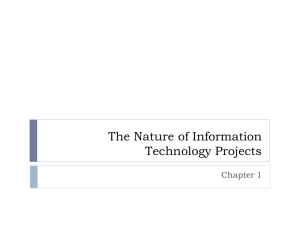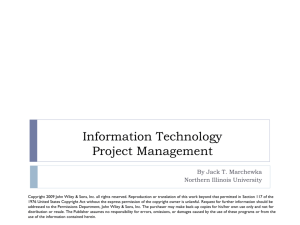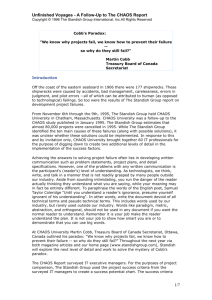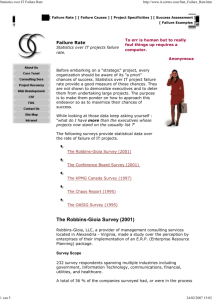Document
advertisement
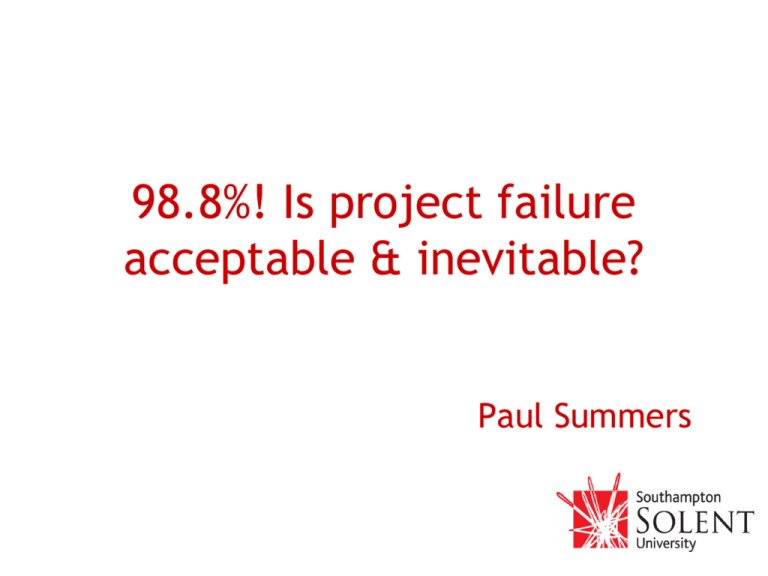
98.8%! Is project failure acceptable & inevitable? Paul Summers The Standish Group • 98.8% project failure – April 2014 when measured against six criteria as follows: • Cost • Time • Value • Scope • Customer satisfaction • Strategic objectives The Standish Group success criteria • Failure when the project is cancelled before completion, • Success is delivery on time, in budget and with all features, • Challenged is anything in between these two outcomes, Top five reasons for failure • Lack of user input; • Incomplete requirements and specifications; • Changing requirements and specifications; • Lack of executive support; • Technology incompetence Flyvbjerg • Underestimated costs and overestimated benefits • Use of deception and lying • Grouped as forecasting errors • The common denominator? • Not the project manager’s fault! Nelson’s retrospectives • • • • • Poor estimating or scheduling; Ineffective stakeholder management; Insufficient risk management Insufficient planning; Short changed quality assurance; The big issue? • No one considers WHY? • Why is planning poor? • What are the conditions which are causing ineffective engagement with stakeholders? • Why does the system promote forecasting errors? Project manager’s lens • The reasons for failure are being viewed through the lens of an inappropriate albeit widespread definition of projects; an output delivered against targets of cost and time. The project manager’s perspective. • “A project is a temporary organisation that is created for the purpose of delivering one or more business products according to an agreed Business case.” (Office of Government Commerce, 2009) • “A project is a temporary endeavour undertaken to produce a unique product, service or result.” Project Management Institute (PMI,2008) Project boundary Change the lens • If the lens is altered to delivering beneficial change then the lists of reasons become symptoms of a limiting worldview caused by pursuing these targets. • “The Standish Group believes that organizations should forget the triple constraints and focus on the value of their project portfolio, not individual projects.” • The business manager’s perspective Business lens • Projects are defined as a temporary endeavour comprising activities with resource constraints with the purpose of realising benefits. • Projects are investments and should be managed as such. • Projects are not just outputs, we must consider the totality of the project Conclusion • Too much of project failure and success is viewed from the perspective of the project manager • Projects need a systemic view to include the achievement of benefits • Project definitions need to broaden to include benefits References • • • • • • • Flyvbjerg, B. (2013). Quality control and due diligence in project management: Getting decisions right by taking the outside view. International Journal of Project Management, 31(5), 760-774. doi: 10.1016/j.ijproman.2012.10.007 Flyvbjerg, B. (2014). What You Should Know About Megaprojects and Why: An Overview. Project Management Journal, 45(2), 6-19. doi: 10.1002/pmj.21409 Flyvbjerg, B., Bruzelius, N., & Rothengatter, W. (2003). Megaprojects and risk An anatomy of ambition (1st ed.). Cambridge: Cambridge University Press. Flyvbjerg, B., & Budzier, A. (2011). Why Your IT Project May Be Riskier Than You Think. Harvard Business Review, 1 - 4. Flyvbjerg, B., Garbuio, M., & Lovallo, D. (2009). Delusion and Deception in Large Infrastructure Projects: Two Models for Explaining and Preventing Executive Disaster. California Mangement Review, 51(2), 170-193. doi: 10.1225/CMR423 Nelson, R. R. (2005). Project retrospectives: evaluating project success, failure, and everything in between. MIS Quarterly Executive, 4(3 September), 361 - 372. Nelson, R. R. (2007). IT Project Management: Infamous Failures, Classic Mistakes, and Best Practctices. MIS Quarterly Executive, 6(2 June). • • • • • • • The Standish Group. (1995). The CHAOS report. The Standish Group. (1996). Unfinished Voyages A Follow-Up to The CHAOS Report. http://www.umflint.edu/~weli/courses/bus381/assignment/vo.pdf The Standish Group. (1999). CHAOS 1999. The Standish Group. (2009). CHAOS Summary 2009. Retrieved 14 June, 2011, from http://www.standishgroup.com/newsroom/chaos_2009.php The Standish Group. (2013). The CHAOS manifesto 2013. The Standish Group. (2014a, 1 April 2014). Definition of Project Success. Retrieved from http://blog.standishgroup.com/news The Standish Group. (2014b). SURF. Retrieved 6 May, 2014, from http://blog.standishgroup.com/surf
